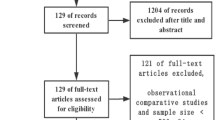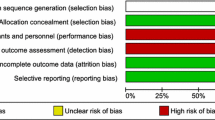Abstract
Background
Conducting preoperative versus intraoperative endoscopic sphincterotomy in patients with gallbladder and suspected common bile duct stones remains controversial. We conducted a meta-analysis to evaluate the outcomes of preoperative endoscopic sphincterotomy (POES) versus intraoperative endoscopic sphincterotomy (IOES).
Methods
We searched multiple electronic databases for prospective, randomized, controlled trials related to safety and effectiveness of POES versus IOES. Relative risk ratios (RRs) were estimated with 95 % confidence intervals (CI) based on an intention-to-treat analysis. We considered the following outcomes: clearance rate, postprocedural complications, and hospital stay.
Results
Five trials with 631 patients (318 with POES, 313 with IOES) were analyzed. Although the overall rates of common bile duct stone clearance were similar between POES and IOES (RR 0.96, 95 % CI 0.91–1.01; p = 0.13), the failure rate of common bile duct cannulation during endoscopic retrograde cholangiopancreatography (ERCP) was significantly higher for IOES (RR 2.54, 95 % CI 1.23–5.26; p = 0.01). The pooled RR after POES for overall complication rates was similar to that for IOES (RR 1.56, 95 % CI 0.94–2.59; p = 0.09). However, compared with IOES, the RR risk of ERCP-related complications was significantly higher for POES (RR 2.27, 95 % CI 1.18–4.40, p = 0.01), especially in the patients at high risk of developing post-ERCP pancreatitis. There was no significant difference in morbidity after laparoscopic cholecystectomy or required subsequent open surgery between the two groups. In the subgroup analyses, the RR risks of post-ERCP pancreatitis were significantly higher for POES (RR 4.85, 95 % CI 1.41–16.66, p = 0.01), and mean hospital stay was longer in the POES group (RR 2.22, 95 % CI 1.98–246; p < 0.01). However, the rates of bleeding, perforation, cholangitis, cholecystitis, and gastric ulceration did not differ significantly between POES and IOES.
Conclusions
With regard to the stone clearance and overall complication rates, POES is equal to IOES in patients with gallbladder and common bile duct stones. However, IOES is associated with a reduced incidence of ERCP-related pancreatitis and results in a shorter hospital stay.




Similar content being viewed by others
References
Martin DJ, Vernon DR, Toouli J (2006) Surgical versus endoscopic treatment of bile duct stones. Cochrane Database Syst Rev (2):CD003327
Vezakis A, Davides D, Ammori BJ, Martin IG, Larvin M, McMahon MJ (2000) Intraoperative cholangiography during laparoscopic cholecystectomy. Surg Endosc 14:1118–1122
Petelin JB (2003) Laparoscopic common bile duct exploration. Surg Endosc 17:1705–1715
Ebner S, Rechner J, Beller S, Erhart K, Riegler FM, Szinicz G (2004) Laparoscopic management of common bile duct stones. Surg Endosc 18:762–765
Velanovich V, Morton JM, McDonald M, Orlando R 3rd, Maupin G, Traverso LW (2006) Analysis of the SAGES outcomes initiative cholecystectomy registry. Surg Endosc 20:43–50
Hungness ES, Soper NJ (2006) Management of common bile duct stones. J Gastrointest Surg 10:612–619
Petelin JB (1991) Laparoscopic approach to common duct pathology. Surg Laparosc Endosc 1:33–41
Phillips EH, Carroll BJ, Pearlstein AR, Daykhovsky L, Fallas MJ (1993) Laparoscopic choledochoscopy and extraction of common bile duct stones. World J Surg 17:22–28
Ponsky JL (2006) Endoluminal surgery: past, present and future. Surg Endosc 20(suppl 2):S500–S502
Cavina E, Franceschi M, Sidoti F, Goletti O, Buccianti P, Chiarugi M (1998) Laparo-endoscopic “rendezvous”: a new technique in the choledocholithiasis treatment. Hepatogastroenterology 45:1430–1435
Lella F, Bagnolo F, Rebuffat C, Scalambra M, Bonassi U, Colombo E (2006) Use of the laparoscopic–endoscopic approach, the so-called “rendezvous” technique, in cholecystocholedocholithiasis: a valid method in cases with patient-related risk factors for post-ERCP pancreatitis. Surg Endosc 20:419–423
Morino M, Baracchi F, Miglietta C, Furlan N, Ragona R, Garbarini A (2006) Preoperative endoscopic sphincterotomy versus laparoendoscopic rendezvous in patients with gallbladder and bile duct stones. Ann Surg 244:889–893
Rabago LR, Vicente C, Soler F, Delgado M, Moral I, Guerra I, Castro JL, Quintanilla E, Romeo J, Llorente R, Vazquez Echarri J, Martinez-Veiga JL, Gea F (2006) Two-stage treatment with preoperative endoscopic retrograde cholangiopancreatography (ERCP) compared with single-stage treatment with intraoperative ERCP for patients with symptomatic cholelithiasis with possible choledocholithiasis. Endoscopy 38:779–786
ElGeidie AA, ElEbidy GK, Naeem YM (2011) Preoperative versus intraoperative endoscopic sphincterotomy for management of common bile duct stones. Surg Endosc 25:1230–1237
Tzovaras G, Baloyiannis I, Zachari E, Symeonidis D, Zacharoulis D, Kapsoritakis A, Paroutoglou G, Potamianos S (2012) Laparoendoscopic rendezvous versus preoperative ERCP and laparoscopic cholecystectomy for the management of cholecysto-choledocholithiasis: interim analysis of a controlled randomized trial. Ann Surg 255:435–439
Hong DF, Gao M, Bryner U, Cai XJ, Mou YP (2000) Intraoperative endoscopic sphincterotomy for common bile duct stones during laparoscopic cholecystectomy. World J Gastroenterol 6:448–450
Wright BE, Freeman ML, Cumming JK, Quickel RR, Mandal AK (2002) Current management of common bile duct stones: is there a role for laparoscopic cholecystectomy and intraoperative endoscopic retrograde cholangiopancreatography as a single-stage procedure? Surgery 132:729–735
Ghazal AH, Sorour MA, El-Riwini M, El-Bahrawy H (2009) Single-step treatment of gall bladder and bile duct stones: a combined endoscopic–laparoscopic technique. Int J Surg 7:338–346
La Greca G, Barbagallo F, Sofia M, Latteri S, Russello D (2009) Simultaneous laparoendoscopic rendezvous for the treatment of cholecystocholedocholithiasis. Surg Endosc 24(4):769–780
Moher D, Liberati A, Tetzlaff J, Altman DG (2009) Preferred reporting items for systematic reviews and meta-analyses: the PRISMA statement. PLoS Med 6:e1000097
Berthou J, Dron B, Charbonneau P, Moussalier K, Pellissier L (2007) Evaluation of laparoscopic treatment of common bile duct stones in a prospective series of 505 patients: indications and results. Surg Endosc 21:1970–1974
Tranter SE, Thompson MH (2002) Comparison of endoscopic sphincterotomy and laparoscopic exploration of the common bile duct. Br J Surg 89:1495–1504
Masci E, Mariani A, Curioni S, Testoni PA (2003) Risk factors for pancreatitis following endoscopic retrograde cholangiopancreatography: a meta-analysis. Endoscopy 35:830–834
Tricarico A, Cione G, Sozio M, Di Palo P, Bottino V, Tricarico T, Tartaglia A, Iazzetta I, Sessa E, Mosca S, De Nucci C, Falco P (2002) Endolaparoscopic rendezvous treatment—a satisfying therapeutic choice for cholecystocholedocolithiasis. Surg Endosc Other Interv Techn 16:585–588
Martin D, Martin I (2008) Flow chart for the treatment of CBDS and critical comparison of techniques. Biliary lithiasis. Springer, Milan, In, pp 357–363
Tricarico A, Cione G, Sozio M, Di Palo P, Bottino V, Tricarico T, Tartaglia A, Iazzetta I, Sessa E, Mosca S, De Nucci C, Falco P (2002) Endolaparoscopic rendezvous treatment: a satisfying therapeutic choice for cholecystocholedocolithiasis. Surg Endosc 16:585–588
Vitale GC (2007) Early management of acute gallstone pancreatitis. Ann Surg 245:18–19
Bergman JJ, Rauws EA, Fockens P, van Berkel AM, Bossuyt PM, Tijssen JG, Tytgat GN, Huibregtse K (1997) Randomised trial of endoscopic balloon dilation versus endoscopic sphincterotomy for removal of bileduct stones. Lancet 349:1124–1129
Freeman ML, Nelson DB, Sherman S, Haber GB, Herman ME, Dorsher PJ, Moore JP, Fennerty MB, Ryan ME, Shaw MJ, Lande JD, Pheley AM (1996) Complications of endoscopic biliary sphincterotomy. N Engl J Med 335:909–918
Martin IJ, Bailey IS, Rhodes M, O’Rourke N, Nathanson L, Fielding G (1998) Towards T-tube free laparoscopic bile duct exploration: a methodologic evolution during 300 consecutive procedures. Ann Surg 228:29–34
Nathanson LK, O’Rourke NA, Martin IJ, Fielding GA, Cowen AE, Roberts RK, Kendall BJ, Kerlin P, Devereux BM (2005) Postoperative ERCP versus laparoscopic choledochotomy for clearance of selected bile duct calculi: a randomized trial. Ann Surg 242:188–192
Rhodes M, Sussman L, Cohen L, Lewis MP (1998) Randomised trial of laparoscopic exploration of common bile duct versus postoperative endoscopic retrograde cholangiography for common bile duct stones. Lancet 351:159–161
Hong DF, Xin Y, Chen DW (2006) Comparison of laparoscopic cholecystectomy combined with intraoperative endoscopic sphincterotomy and laparoscopic exploration of the common bile duct for cholecystocholedocholithiasis. Surg Endosc 20:424–427
Wei Q, Wang JG, Li LB, Li JD (2003) Management of choledocholithiasis: comparison between laparoscopic common bile duct exploration and intraoperative endoscopic sphincterotomy. World J Gastroenterol 9:2856–2858
Rojas-Ortega S, Arizpe-Bravo D, Marin Lopez ER, Cesin-Sanchez R, Roman GR, Gomez C (2003) Transcystic common bile duct exploration in the management of patients with choledocholithiasis. J Gastrointest Surg 7:492–496
Topal B, Aerts R, Penninckx F (2007) Laparoscopic common bile duct stone clearance with flexible choledochoscopy. Surg Endosc 21:2317–2321
Hammarstrom LE, Holmin T, Stridbeck H, Ihse I (1995) Long-term follow-up of a prospective randomized study of endoscopic versus surgical treatment of bile duct calculi in patients with gallbladder in situ. Br J Surg 82:1516–1521
Suc B, Escat J, Cherqui D, Fourtanier G, Hay JM, Fingerhut A, Millat B (1998) Surgery vs endoscopy as primary treatment in symptomatic patients with suspected common bile duct stones: a multicenter randomized trial. French Associations for Surgical Research. Arch Surg 133:702–708
Targarona EM, Ayuso RM, Bordas JM, Ros E, Pros I, Martinez J, Teres J, Trias M (1996) Randomised trial of endoscopic sphincterotomy with gallbladder left in situ versus open surgery for common bileduct calculi in high-risk patients. Lancet 347:926–929
Saccomani G, Durante V, Magnolia MR, Ghezzo L, Lombezzi R, Esercizio L, Stella M, Arezzo A (2005) Combined endoscopic treatment for cholelithiasis associated with choledocholithiasis. Surg Endosc 19:910–914
Enochsson L, Lindberg B, Swahn F, Arnelo U (2004) Intraoperative endoscopic retrograde cholangiopancreatography (ERCP) to remove common bile duct stones during routine laparoscopic cholecystectomy does not prolong hospitalization: a 2-year experience. Surg Endosc 18:367–371
Freeman ML, DiSario JA, Nelson DB, Fennerty MB, Lee JG, Bjorkman DJ, Overby CS, Aas J, Ryan ME, Bochna GS, Shaw MJ, Snady HW, Erickson RV, Moore JP, Roel JP (2001) Risk factors for post-ERCP pancreatitis: a prospective, multicenter study. Gastrointest Endosc 54:425–434
Meyer C, Le JV, Rohr S, Thiry LC, Duclos B, Reimund JM, Baumann R (1999) Management of common bile duct stones in a single operation combining laparoscopic cholecystectomy and perioperative endoscopic sphincterotomy. Surg Endosc 13:874–877
Lau JY, Leow CK, Fung TM, Suen BY, Yu LM, Lai PB, Lam YH, Ng EK, Lau WY, Chung SS, Sung JJ (2006) Cholecystectomy or gallbladder in situ after endoscopic sphincterotomy and bile duct stone removal in Chinese patients. Gastroenterology 130:96–103
Boerma D, Rauws EA, Keulemans YC, Janssen IM, Bolwerk CJ, Timmer R, Boerma EJ, Obertop H, Huibregtse K, Gouma DJ (2002) Wait-and-see policy or laparoscopic cholecystectomy after endoscopic sphincterotomy for bile-duct stones: a randomised trial. Lancet 360:761–765
Allen NL, Leeth RR, Finan KR, Tishler DS, Vickers SM, Wilcox CM, Hawn MT (2006) Outcomes of cholecystectomy after endoscopic sphincterotomy for choledocholithiasis. J Gastrointest Surg 10:292–296
Schiphorst AH, Besselink MG, Boerma D, Timmer R, Wiezer MJ, van Erpecum KJ, Broeders IA, van Ramshorst B (2008) Timing of cholecystectomy after endoscopic sphincterotomy for common bile duct stones. Surg Endosc 22:2046–2050
Gurusamy K, Wilson E, Burroughs AK, Davidson BR (2012) Intra-operative vs pre-operative endoscopic sphincterotomy in patients with gallbladder and common bile duct stones: cost-utility and value-of-information analysis. Appl Health Econ Health Policy 10:15–29
Disclosures
Drs. B. Wang, Z. Y. Guo, Z. J. Liu, Y. Wang, Y. Si, Y. F. Zhu, and M. J. Jin have no conflicts of interest or financial ties to disclose.
Author information
Authors and Affiliations
Corresponding author
Additional information
Bing Wang and Zhenying Guo contributed equally to this work, and both should be considered first author.
Rights and permissions
About this article
Cite this article
Wang, B., Guo, Z., Liu, Z. et al. Preoperative versus intraoperative endoscopic sphincterotomy in patients with gallbladder and suspected common bile duct stones: system review and meta-analysis. Surg Endosc 27, 2454–2465 (2013). https://doi.org/10.1007/s00464-012-2757-7
Received:
Accepted:
Published:
Issue Date:
DOI: https://doi.org/10.1007/s00464-012-2757-7




